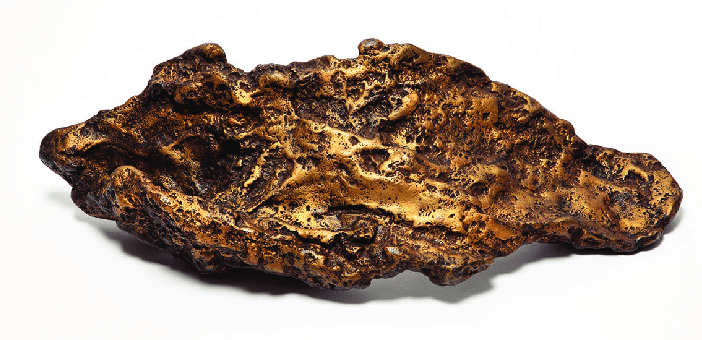
The 10 Biggest Gold Nuggets in Australia
While the exact sizes and weights of gold nuggets can vary slightly depending on the source, below is a list of some of the biggest gold nuggets in Australia:
1. The Welcome Stranger Nugget
Discovered in 1869 near Moliagul, Victoria, this nugget is considered the largest gold nugget ever found, let alone the biggest gold nugget in Australia, weighing approximately 72 kg (2,315 troy ounces).
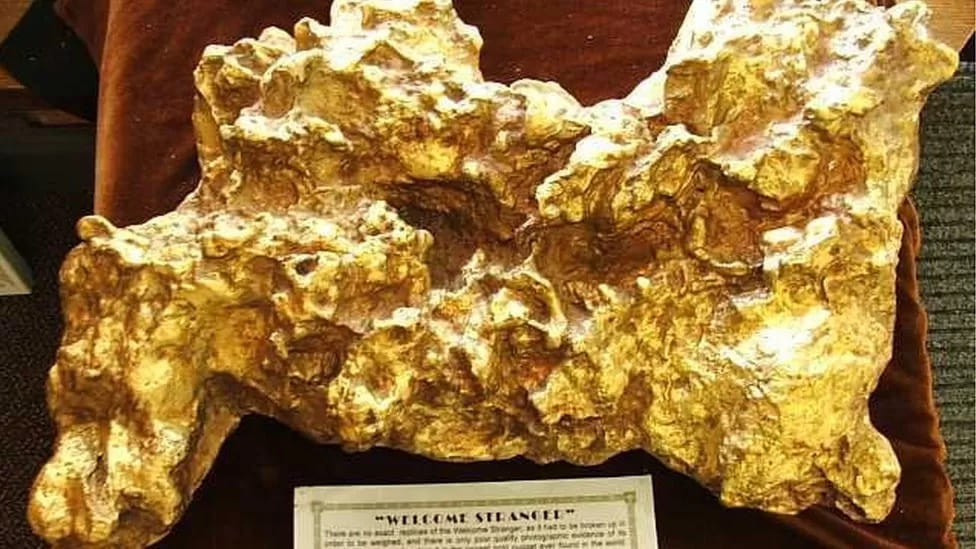
In the 1850s, thousands of people travelled to Australia in search of their fortune.
They came from across Australia and from around the world, and for most of these people, great wealth was never achieved.
But for two Cornish miners, fortune did come calling on 5 February 1869.
John Deason and Richard Oats were originally tin miners from Cornwall, who emigrated to Australia in 1853 to begin their lives as prospectors in the Victorian Gold Rushes.
In 1862 they arrived in Moliagul, Victoria and after 7 years of just getting by, and hardly making a living, the two men struck gold.
On a slope called Bulldog Gully, an enormous piece of gold encased in quartz was buried just below the surface.
It was so big, that as Mr Deason wrote "I tried to prise the nugget up with the pick, but the handle broke. I then got a crowbar and raised the nugget to the surface".
They then took the nugget into the town of Dunolly, about 20km away, where it was weighed at the London Chartered Bank.
To get a value of its weight, the nugget was immediately broken up on an anvil at the local blacksmith’s, before it could finally fit on the bank's scales.
After smelting, it yielded 2,302 oz (about 71 kg) of solid gold.
Deason and Oates shared the fortune of nearly £10,000, which would be roughly about $2 million Australian dollars in today's money.
If it was still in existence, just its the contained gold would be worth $6.8 million dollars, but, it would sell for multiples of this price, purely because of its rarity and historic value.
2. The Welcome Nugget
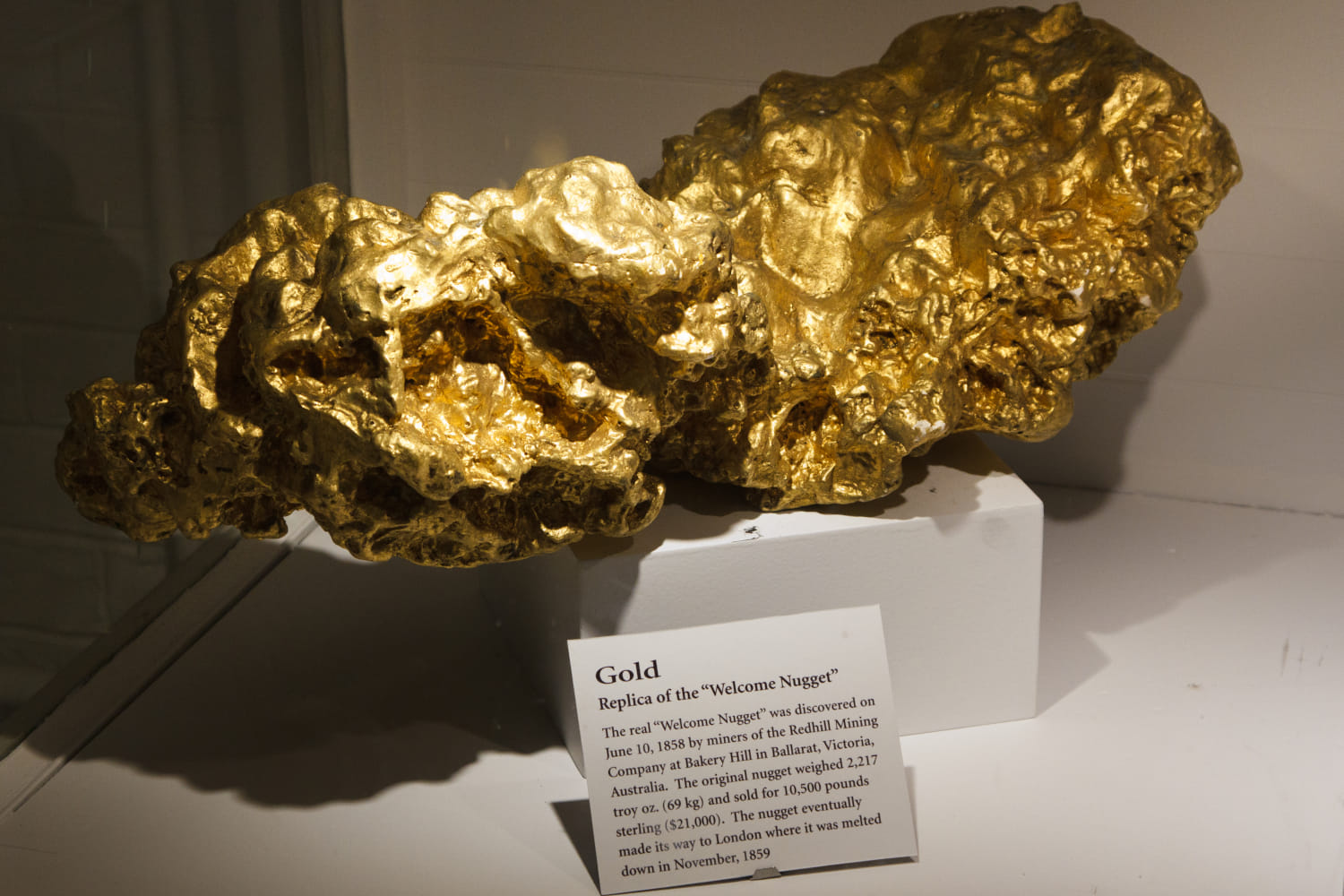
Found in 1858 at the Red Hill Mining Company site in Ballarat, Victoria, this nugget weighed around 69 kg (2,217 troy ounces).
In 1857, a party of 22 experienced Cornish copper miners left the south-west of Britain and set out to seek their fortunes in the gold fields of Victoria, Australia.
The group arrived in Melbourne in early 1858 and headed out to Creswick to try their luck.
With nothing to show after 2 months, the party decided to give Ballarat a go!
Initially, for the first few weeks they looked about about the region, trying to find a good location, and then decided to try their luck in one of the abandoned shafts left by disappointed diggers who had gone off to the new Deep Lead mines up on the plateau.
They chose an abandoned shaft near the corner of Mair and Humffray Streets, then known as the Black Hill road.
The men organised themselves into a proper company, which they called the "Red Hill Gold Mining Company", consisting of twenty-two working shareholders.
It is interesting to note that this was the first company to use a steam engine to haul the wash dirt to the surface.
In March, 1858, they went down to the 180 foot deep shaft and planked up the sides. They sank 20 feet deeper, and came on the Black Hill gutter. They followed this along, getting a little gold.
In May, they had found two nice nuggets, one weighing 45 ounces and the other12 ounces, plus a few smaller nuggets.
These gold discoveries had added to their gold fever, and they divided themselves into three shifts, and so were able to keep the work going for twenty-four hours every day.
On the evening of the 9th June, the evening shift was busy digging away. The day shift had eaten crib (dinner) and crawled into their bunks for their well-earned sleep.
At 7.30pm, one of the miners found his pick had struck something hard. At first he thought it was just a lump of stone.
But soon, his eyes caught a glimpse of gold. He yelled to his fellow miners to help him. Between them they gradually drew out of the clay a huge lump of gold.
For half an hour they sweated, levering the monster nugget into the cage where it was pulled to the surface, where they told their sleeping partners.
We can only imagine the excitement of these sleepy Cornishmen as they throw on clothes and rushed over to mine shaft.
The happy Cornishmen are rumoured to have sat up all night, feasting their eyes on their precious find.
They got some bottles of beer and christened it the Welcome Nugget.
Next morning it was levered up into a wheel barrow, and diggers going to work were thrilled to see a procession of twenty-two men escorting to the Treasury in Lydiard street this golden giant.
At the Ballarat Treasury it weighed in at 2,217 ounces (68.95 kilograms).
In the Ballarat "Miner" of 11th June, there was an advertisement stating that the Welcome Nugget would be exhibited in town with admission being 1 penny. All of the proceeds to aid the Miners' Hospital.
Hundreds of people came to see "The wonder of the world" lying proudly on a background of rich black velvet. Every mother was allowed to put her baby astride the nugget, in the hope the child would be assured a lucky future.
An enterprising firm of gold buyers, the Witkowski Brother's bought the nuggets for 10,050 pounds, and exhibited it to crowds in Melbourne. For a fee of course!
In the Melbourne press of 9th August, 1858, was an advertisement, and I quote "the Welcome Nugget", the "Nil Desperandum Nugget" and other beautiful specimens of Ballarat gold would be on exhibition"
Once the Witkowski Browsers had finished, it was on-sold and eventually taken to London, and exhibited in the Crystal Palace.
Finally, in November, 1859. it was taken to the London Mint and melted down and made into gold sovereigns.
A granite monolith, on the corner of Mair and Humffray Streets, Ballarat, mark the site of the finding of this monster nugget.
3. Hand of Faith
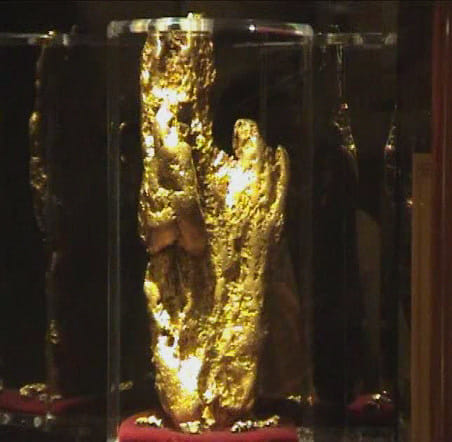
Unearthed in 1980 near Kingower, Victoria, this gold nugget weighs 27.2 kg (875 troy ounces) and is the largest gold nugget found using a metal detector.
The Hand of Faith is not just a gold nugget; it symbolizes a remarkable chapter in Australia's gold mining history. Discovered on September 26, 1980, by Kevin Hillier near Kingower, Victoria, this nugget has captivated the imagination of treasure hunters and history enthusiasts alike.
Kevin Hillier, equipped with a metal detector, stumbled upon the Hand of Faith just 12 inches below the surface. Weighing an impressive 875 troy ounces (approximately 27.21 kg), it is recognized as the largest gold nugget ever found with a metal detector. The dimensions of the nugget are notable as well, measuring 47 cm x 20 cm x 9 cm (18.5 in x 7.9 in x 3.5 in)
The announcement of this significant find took place at a press conference in Melbourne on October 8, 1980, attended by Victoria's Premier Dick Hamer. Hillier's discovery quickly garnered international attention, inspiring many to take up prospecting in the area.
After its discovery, the Hand of Faith was sold to the Golden Nugget Casino in Las Vegas for over $1 million, a sum that would be equivalent to more than $4 million today when adjusted for inflation. Currently, it resides on public display at the Golden Nugget Las Vegas, where it continues to attract visitors from around the world.
4. Poseidon Nugget
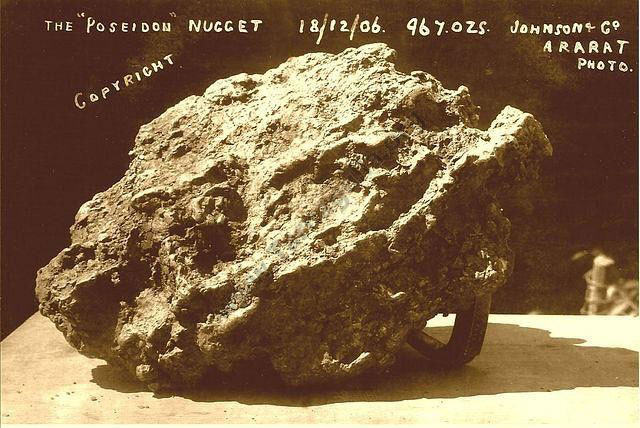
The Poseidon Nugget, discovered on December 18, 1906, near Tarnagulla, Victoria, is one of Australia's most notable gold finds. Weighing an impressive 29.6 kilograms (approximately 68.5 pounds), this nugget is celebrated not only for its size but also for the story behind its discovery and its place in the rich tapestry of Australia's gold mining heritage.
The Poseidon Nugget was unearthed during a time when gold mining was at its peak in Victoria, particularly in the region known as the Golden Triangle, which encompasses Bendigo, Ballarat, and St Arnaud. This area was famous for producing significant gold finds during the 19th and early 20th centuries, contributing to the global reputation of Australia as a gold-rich nation.
The nugget was named after the racehorse Poseidon, which won the Melbourne Cup in 1906. This naming reflects the cultural intersection between sporting events and mining discoveries that characterized the era. The Poseidon Lead, where the nugget was found, became known for yielding a concentration of gold nuggets, further enhancing its allure for prospectors.
The Poseidon Nugget measures approximately 39 centimeters (15.4 inches) in length and is composed of both quartz and gold. Its unique formation showcases the natural beauty of gold in its raw state, making it a prized specimen among collectors and historians alike.
5. The "Golden Eagle" Nugget
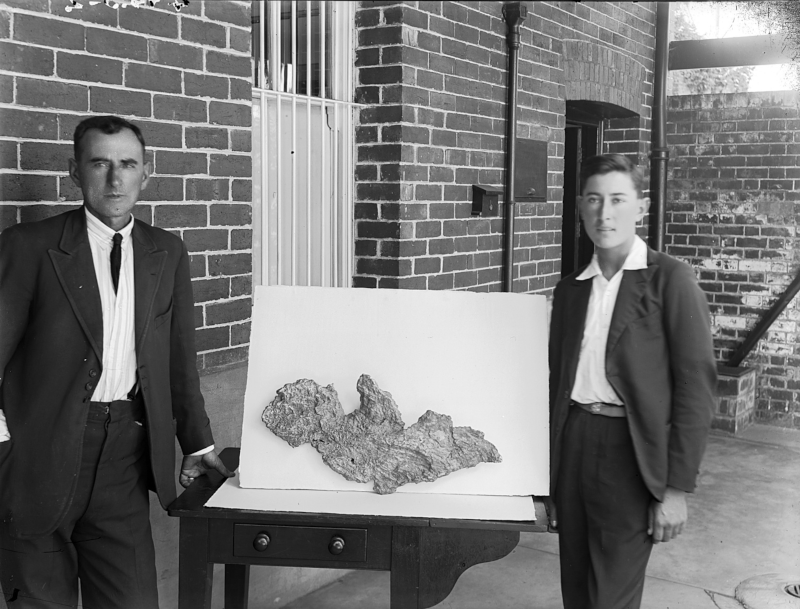
The Golden Eagle Nugget holds a prominent place in the annals of Australian gold mining, celebrated as the largest gold nugget ever discovered in Western Australia. Unearthed on January 15, 1931, by 16-year-old Jim Larcombe near the now-abandoned town of Widgiemooltha, this remarkable find not only represented a significant financial boon but also sparked a renewed gold rush during a time of economic hardship.
Jim Larcombe was working alongside his father, James Larcombe, when he struck gold just 45 centimeters below the surface. The nugget weighed an astonishing 1,136 troy ounces (approximately 35.3 kilograms) and measured about 66 centimeters long, 29 centimeters tall, and 6.4 centimeters thick. Its unique shape resembled that of an eagle with outspread wings, which inspired its name. The discovery came at a time when many prospectors were struggling due to the Great Depression. The excitement surrounding the Golden Eagle Nugget brought a wave of hope and investment to the region, encouraging others to seek their fortunes in the goldfields.
Upon its discovery, the nugget was sold to the Western Australian government for £5,438, which would be equivalent to over $570,000 AUD today. Unfortunately, just a year later, in December 1931, it was melted down to raise funds for the state during the economic crisis
6. The Pride of Australia

Rod Steed, a Victorian prospector, had a serious case of gold fever on his 70th birthday in May 1981. Instead of sleeping in or enjoying a leisurely breakfast, he was out in the bush by 7 a.m. on a bright autumn morning. He was at Mosquito Gully, near Wychitella—just 11 kilometers north of Wedderburn—swinging his Garrett metal detector around.
Before long, he picked up a solid signal next to a dirt track. Less than an hour later, Rod was back home with an incredible 256-ounce gold nugget sitting proudly on his dining room table. You can imagine his excitement when he called up two of his prospecting buddies who lived nearby to share the big news!
Rod was part of a four-man partnership, and they had agreed that whenever one of them found gold in their shared prospecting area, they would all split the treasure. The guys gathered to check out the nugget and decided to name it the “Pride of Australia” because it kind of looked like a rough map of the continent.
Interestingly, Tasmania missed out on this one! A smaller nugget found underneath the Pride of Australia did vaguely resemble the island, though. Meanwhile, the fourth member of their group, Brian Shelton, was in Switzerland negotiating a sale for some gold specimens when he got the urgent call to come home—though they didn’t tell him just how significant this find really was.
As the group's spokesperson, Brian was the one who officially announced the discovery. Later on, he showed the nugget to Dr. Birch at the Museum of Victoria. They even took a plaster cast for official records before launching their campaign to preserve this remarkable nugget.
At that time, if you melted it down, its gold content was worth about $80,000, but as a specimen, it was estimated to be worth around $250,000. Fast forward to today, and that value would be around $1.17 million!
Brian and Dr. Birch traveled across Australia’s eastern states looking for an Australian buyer. They even brought the Pride of Australia to Parliament House in Canberra to try and persuade lawmakers to buy it for the nation. The nugget caused quite a stir as it passed from MP to MP, but no one took the bait until almost two years later when the State Bank of Victoria stepped in.
Mr. Jack Roach, the bank’s chief marketing manager at the time, recognized that this nugget was the last major specimen of alluvial gold left in Australia. The bank decided to preserve it for Victoria’s 150th Anniversary celebration. It was first displayed at the State Bank's headquarters in Melbourne before being permanently exhibited at the Museum of Victoria.
But unfortunately, its story took a dramatic turn! On August 28, 1991, a security guard noticed something strange while walking past the museum after closing time. He discovered that someone had broken into a fire door panel! The thieves made their way to where the gold nugget was displayed and smashed open its case with a sledgehammer—making off with it in just three minutes!
Despite tight security measures—including alarms that mysteriously failed—the thieves and the nugget were never found. The whole incident remains one of Australia’s most notorious art thefts!
7. The Viscount Canterbury Nugget
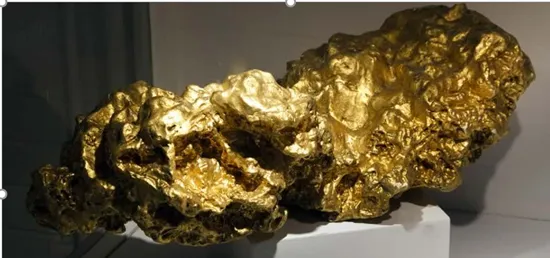
The Viscount Canterbury Nugget is a fascinating piece of Australia’s gold mining history, with a story that dates back to 1871. This nugget was discovered in the small town of Rheola, located in central Victoria, and it weighed an impressive 1,110 ounces (about 31.5 kilograms).
Imagine being a prospector back in the 1870s, armed with nothing but a pick and a dream. That’s exactly what happened when the Viscount Canterbury Nugget was found. It was one of several large nuggets unearthed during this period, showcasing the rich gold deposits that Victoria had to offer. At that time, Rheola was buzzing with activity as prospectors flocked to the area, hoping to strike it rich.
The Viscount Canterbury Nugget was notable not just for its size but also for the excitement it generated. Large nuggets like this one were rare, and finding one could change a prospector's life overnight. In fact, this nugget was so significant that it became part of a larger narrative about the gold rush era in Australia.
While many nuggets were melted down shortly after discovery for their gold content, the Viscount Canterbury Nugget has remained a point of interest among historians and gold enthusiasts. It serves as a reminder of the wealth that once flowed through the region and how these finds shaped the lives of countless individuals.
8. Lady Loch Nugget
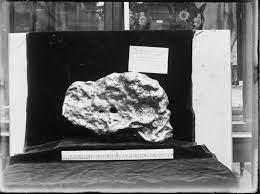
The Lady Loch Nugget is a fascinating piece of gold mining history that hails from the bustling goldfields of Ballarat, Victoria. Discovered in 1887, this nugget weighed an impressive 617 ounces (about 17.5 kilograms) and quickly became a symbol of the excitement and opportunity that characterized the gold rush era.
It’s a sunny day in Ballarat, and prospectors are out in full force, hoping to strike it rich. The Lady Loch Nugget was found at the Midas Gold Mine in Dowling Forest, which was leased by Alice Cornwell, a pioneering figure in the mining industry. Alice was known for her keen eye for potential mining sites, and her hard work paid off when this massive nugget was unearthed.
The nugget was named after the wife of the Governor of Victoria at the time, Lady Loch. Its discovery sent shockwaves through the local community, igniting excitement among miners and investors alike. It wasn’t just a significant find; it represented hope for many who had come to Ballarat seeking fortune.
9. The Blanche Barkly Nugget

Discovered in Kingower, Victoria, in 1857, this nugget weighed a staggering 1,743 ounces (about 49.5 kilograms), making it one of the largest gold nuggets ever found.
Imagine being a prospector in the mid-1800s, armed with just a pick and a dream of striking it rich. That’s exactly what happened when Scottish prospector Sam Napier and his team unearthed the Blanche Barkly Nugget. They were working in an area that had already seen its fair share of gold fever, but this find was something special.
The nugget was named in honour of Blanche Barkly, the daughter of the then-colonial Governor of Victoria, Sir Henry Barkly. It was a fitting tribute, as the nugget itself became a symbol of wealth and opportunity during a time when many were searching for their fortunes.
After its discovery, the Blanche Barkly Nugget became quite the celebrity. It was displayed at London’s Crystal Palace, where it drew crowds eager to see this massive piece of gold. Eventually, it was sold to the Bank of England, where it was melted down to create sovereign coins. While this might seem like a sad fate for such a remarkable find, it reflects the reality of gold mining at the time—where monetary value often took precedence over preservation.
10. The Little Hero Nugget
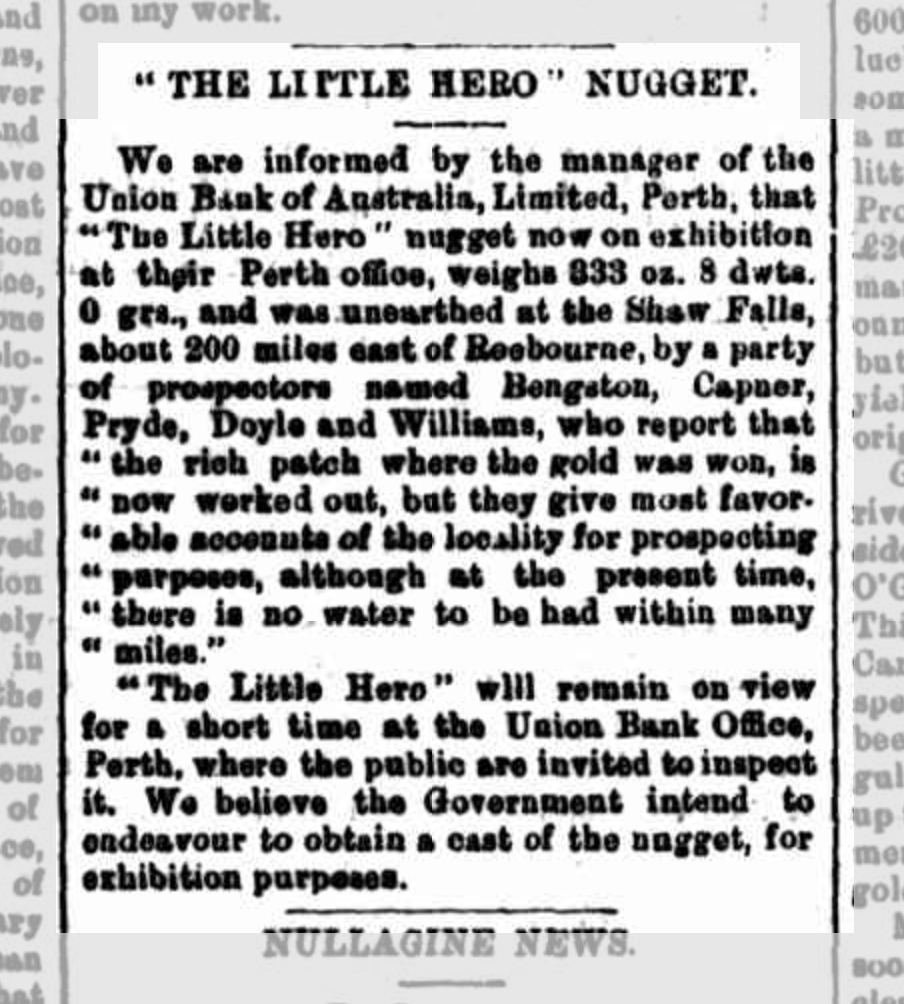
Unearthed in 1890 in the Shaw Falls, near Roebourne Victoria, this nugget weighed approximately 25.9 kg (833 troy ounces), this nugget quickly became a symbol of the excitement and opportunity that characterized the gold rush era.
These nuggets represent just a fraction of the gold discoveries in Australia, which has a rich history of gold mining and continues to be a major producer of the precious metal.
I hope you enjoyed that list of the 10 Biggest Gold Nuggets in Australia